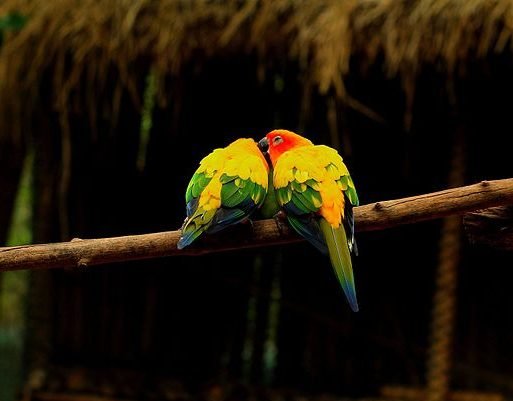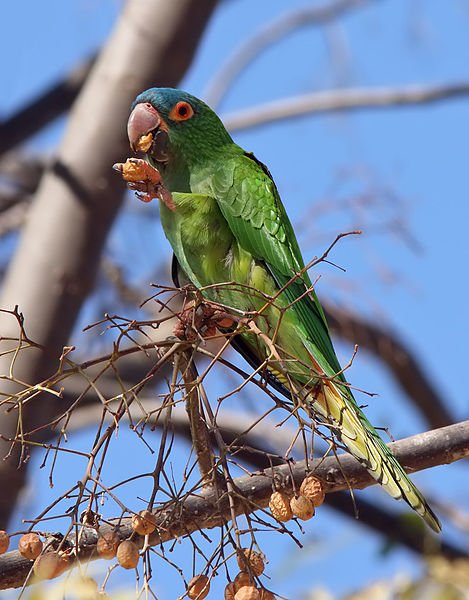Native to Hawaii, the Red Factor Sun Conure is a mesmerizing personality. In the conure world, red factor sun conure is reckoned to be the “Premium one”. Why? Simply having a look at their rarity vis-a-vis their extreme demand clears the air around this bird’s star status. And it’s hard, not only to find a red factor sun conure but also to find a breeder that sells them.
Red factor sun conures are extremely expensive. The red factor sun conures color mutation was practiced over a decade ago. In the US, breeders and pet owners primarily love to collect these charming gems. Red factor sun conures pull the attention of those who are much interested in conure’s color mutation. But they have more to them than just their pretty colors.
Red Factor Sun Conure Talking Ability
Red factor sun conures are not expected to talk a lot. To make red factor sun conures talk, one needs to have a good sense of patience and training skills. Some red factor sun conures indeed develop talking abilities but not as much as other parrots like African Greys. And even if one finds a talking red factor sun conure, the bird probably wouldn’t be practicing extensive vocabulary. They must be taught easy words and phrases.
Furthermore, red factor sun conures can make other sounds well. They have uncanny mimic abilities. They can imitate sounds of doorbells, telephone chimes, microwave buzzers, daily grind, treadmill, and/or barking dogs well.
Red Factor Sun Conure Price
Red factor sun conures are the rare ones. They are rarely bred because they are expensive. While the other conure species’ price stays around $50 to $150. The red factor’s prices start at $600. And more often than not, it is hard to get one below $700. However, even the base price may vary depending on the location. And about the upper price range, it can be as high as $1500. Thus, they are the most expensive conures.
Red Factor Sun Conure Lifespan
Red factor sun conures stay alive for 25 to 30 years. However, with proper care and a healthy diet, their lifespan can extend up to 35 years.
Red Factor Sun Conure Color
Red factors are completely red since birth. They appear bright reddish on the whole head, belly, chest, upper wings, and legs. And that gives them the name of a ‘red factor’. The color mutation is very rare. This bright red color develops more intensely as the baby gets older.
Another fact of them is as they get older, they are more orange than red. At the age of 3 months, their feathers start to grow out with a slight yellow tinge.
Difference between Sun Conure and Red Factor Sun Conure
Many people believe that red factor sun conures and sun conures are different names of the same bird/species. But the reality is indeed different. One can easily note down the difference if he sees them together. The red factor sun conures are a completely different personality compared to the sun conures.
That said, they share many traits. Like both red factors and sun conures are small-sized birds. Both love to hang out, sometimes all day long. They simply enjoy all the fun and play. And lastly, both are perfect pets.
While the similarities aren’t dominating enough, the differences are:
- Regular sun conures have more yellow plumage with orange spots. Whereas, red factor sun conures have a reddish-orange washing over the yellow part of a sun conure. Their whole front body is more red than yellow/orange.
- They can be easily identified by looking at their wings. No matter, a red-factor sun conure is a baby or an adult, they always have a red spot or reddish tinge on their wings.
- Another difference between red factors and sun conures is that sun conures are easily available. Breeders breed them regularly for their demand all year round. But this is not the case with red factors. They aren’t easily available. Neither can they be easily found. Even finding a breeder that breeds or sells a red factor is rare.
- Red factor sun conures are comparatively expensive. Sun conures may cost around $150. And the upper range is never much far from this price in any part of the world. But when it comes to red factor sun conures, their prices can rise to $1500; a whopping 10 times of the sun’s price. It is rightly said that red factor sun conures are way extremely expensive.
Red Factor Sun Conure Gender Difference
There is no difference between a red factor sun conure male and female. The red factor in them is not sex-linked. The visually reddish color carries the color gene as well. Hence, to know a red factor’s gender, one has to go the scientific way, i.e. DNA testing.
Red Factor Sun Conure Behavior and Temperament
When it comes to behavior, these small parrots are more like playful clowns. Mostly they can be found lying on their backs or dangling from a toy rope. Red factor sun conures are highly loyal to a good owner. They easily get more attached to the owner when pampered even a little. Though not as much as a cockatoo, they are cuddly and affectionate. They always like their human companion to stay around for hours.
These small parrots can always be easily trained owing to their curious nature. They take well to the training sessions and can be tamed in no time if done with patience and right skill. Moreover, they are intelligent enough to understand the instructions well.
Red Factor Sun Conure Care
Red factor sun conure love to stay out of his cage. This bird wants a good playtime and his owner’s attention. Unlike a few other parrot species, red factors can be paired with other conures. And mostly, they are paired with sun conures.
Red factor sun conures need to be served a nutrient-rich diet. Their foremost requirement is a fresh, clean, filtered, and chlorine-free. The water must be changed daily. For eating purposes, a wide variety of fruits and vegetables can be offered. Offer them carrots, peas, spinach, and such other vegetables for a wholesome feed.
Red factor sun conures must be served specialized pellets. It must form roughly 60 to 70% of their diet. Along with this, a little amount of fortified seeds can be offered as a delectable treat.
Things to remember about Red factor sun conures care:
- Freshwater and fresh food must always be available in their cage.
- If the vegetables and fruits are not consumed within three hours, discard them immediately.
- The treats provided to the red factors should not be more than 10% of their total diet.
- These birds must not be fed avocado, fruit seeds, chocolates, caffeine, and alcohol. All such foods may cause serious health issues to a red factor. Additionally, avoid foods that are high in fat like sugar.
Red Factor Sun Conure Cage
Red factor sun conure’s cage temperature should lie between 65°F to 80°F. Frequent changes in temperature must be avoided. The cage of a red factor must be placed off the floor. It should be well-lit and away from the drafts.
The ideal dimension of a red factor’s cage is 30″W × 30″D × 36″H. It should feature a strong metal bar ½” apart. Always try to offer them the largest cage possible. This makes it easy for the bird to flex his wings comfortably.
Red factors can either be kept alone or paired with sun conures. However, other species should not be allowed to stay with a red factor inside the same cage.
Are Red Factor Sun Conures Hybrid?
Red factor sun conures aren’t hybrid. They are purebred indeed. The color they have is typically matched to sun conures. It can dispel any conjecture of hybridization.
Red Factor Sun Conure Hygiene
These small birds deserve extra care. Red factor sun conures must be provided filtered, chlorine-free, lukewarm water for bathing daily. Once the bird is done with bathing, the water should be discarded. Alternatively, one can mist them with water. Their nails and beak must be trimmed timely. It requires a qualified and trained person so as not to make an injury to the parrot. A strict hygiene routine is imperative to help this bird live longer.
For avoiding infections, clipping flight feathers is usually preferred. But it should be done very carefully. The correct way of clipping flight feathers can prevent injury. For this, it’s advisable to consult an avian veterinarian or any other professional.
Summing Up
Red factor sun conures are not a common species like most others. They are rare. They are expensive. And they are special. They are called a premium for a reason. People who are mesmerized by vivid colors are always on a lookout for a red factor sun conure. They are small red washed conures who don’t talk a lot but can make a lot of noise. After all, they are a conure. Despite all this, they are in great demand for their giving natures and great companionship.
Featured Photo Credit: lionpro2006 / CC BY (https://creativecommons.org/licenses/by/2.0)
Follow this link for more interesting articles about Conures.




